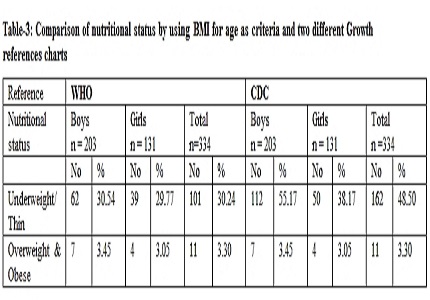Nutritional status of preschool children -a school based study
Abstract
Objective: (1) To estimate the prevalence of Overweight, Obesity and Underweight amongst preschool children in urban nursery schools from Pune (2) To compare the two growth references that can be used to assess the BMI status of preschool children and (3) To compare BMI for age / gender with Weight for age / gender to define Overweight and Obesity.
Methods: It is an observational study with 334 preschool children of 4 years of age from urban nursery schools of Pune. They were examined during annual health check-up. Anthropometric measurements such as Body weight (Wt.), height (Ht.) were taken and Body Mass Index (BMI) was calculated. Child Growth standards released by the World Health Organization and CDC charts were used to define obesity, overweight and underweight. Cutoff values for nutritional status using ‘weight for age’ as criteria was defined as > 85th percentile being Overweight, > 97th percentile being obesity and < 3th percentile as underweight. Using BMI criteria Overweight was defined as > 85th percentile, obesity > 95th percentile and underweight as < 5th percentile.
Results: The prevalence of overweight, obesity, and underweight was 2.1%, 1.2% and 29.77 % respectively using BMI for age /gender as criteria and WHO growth reference charts. Amongst two growth references used to assess BMI; Underweight was overestimated by CDC growth charts.
Conclusion: The Prevalence of overweight and obesity among preschool children of Pune were lower than that of preschool children of developed countries and other parts of India. Under nutrition is still a problem for preschool children. BMI for the age and gender is a better indicator to pick up nutritional status of preschool children than weight for age.
Downloads
References
2. Popkin BM. The nutrition transition and obesity in the developing world. J Nutr 2001; 131:871S-3S. [PubMed]
3. de Onis M, Blössner M, Borghi E. Global prevalence and trends of overweight and obesity among preschool children. Am J Clin Nutr. 2010 Nov;92(5):1257-64. doi: 10.3945/ajcn.2010.29786. Epub 2010 Sep 22. [PubMed]
4. Mumbai: International Institute of Population Science; 2005-06. National Family Health Survey-3. [PubMed]
5. WHO Multicentre Growth Reference Study Group. WHO Child Growth Standards based on length / height weight,and age. Acta Paediatr Suppl.2006; 450:76-85. [PubMed]
6. 2000 CDC growth charts, 2-19 years of age, Developed by the National Center for Health Statistics in collaboration with the National Center for Chronic Disease Prevention and Health Promotion (2000). Available from: http://www.cdc.gov./growthcharts.
7. Department of Health. National child measurement programme: England, 2009/10 school year. In: Department of Health, eds. Department of Health. London: The Health and Social Care Information Centre; 2010: 3-62.
8. Elder JP, Crespo NC, Corder K, Ayala GX, Slymen DJ, Lopez NV, Moody JS, McKenzie TL. Childhood obesity prevention and control in city recreation centres and family homes: the MOVE/me Muevo Project. Pediatr Obes. 2014 Jun;9(3):218-31. doi: 10.1111/j.2047-6310.2013.00164.x. Epub 2013 Jun 11. [PubMed]
9. Jiang J, Rosenqvist U, Wang H, Greiner T, Ma Y, Toschke AM. Risk factors for overweight in 2- to 6-year-old children in Beijing, China. Int J Pediatr Obes. 2006;1(2):103-8. [PubMed]
10. Gaeini A, Kashef M, Samadi A, Fallahi A. Prevalence of underweight, overweight and obesity in preschool children of Tehran, Iran. Int J Obes Relat Metab Discord, 2000 Aug; 24(8): 959-67. [PubMed]
11. Kumar HN, Mohanan P, Kotian S, Sajjan BS, Kumar SG. Prevalence of overweight and obesity among preschool children in semi urban South India. Indian Pediatr. 2008 Jun;45(6):497-49. [PubMed]
12. Navdeep Kaur, Sandeep Kaur Sidhu, Sharda Sidhu. Prevalence of Overweight and obesity in preschool children of Amritsar, Punjab. Anthropologist, 2010; 12(3): 221-224.
13. Thongbai W, Fongkaew W, Kennedy CM et al. Risk factors contributing to overweight among preschool children. Pacific Rim Int J Nurs Res.2011; 15(1): 13-27.
14. Jouret B, Ahluwalai N, Cristini C et al. Factors associated with overweight in pre-school age children in south-western France. Am J Clin Nutr 2000; 72: 1032-9.
15. Marwaha RK, Tandon N, Singh Y, Aggarwal R, Grewal K, Mani K. A study of growth parameters and prevalence of overweight and obesity in school children from delhi. Indian Pediatr. 2006 Nov;43(11):943-52. [PubMed]
16. Sidhu S, Marwah G, Prabhjot. Prevalence of overweight and obesity among the affluent adolescent school children of Amritsar, Punjab. Coll Antropol. 2005 Jun;29(1):53-5. [PubMed]
17. Ramachandran P, Gopalan HS. Assessment of nutritional status in Indian preschool children using WHO 2006 Growth Standards. Indian J Med Res. 2011 Jul;134:47-53. [PubMed]

Copyright (c) 2016 Author (s). Published by Siddharth Health Research and Social Welfare Society

This work is licensed under a Creative Commons Attribution 4.0 International License.


 OAI - Open Archives Initiative
OAI - Open Archives Initiative


